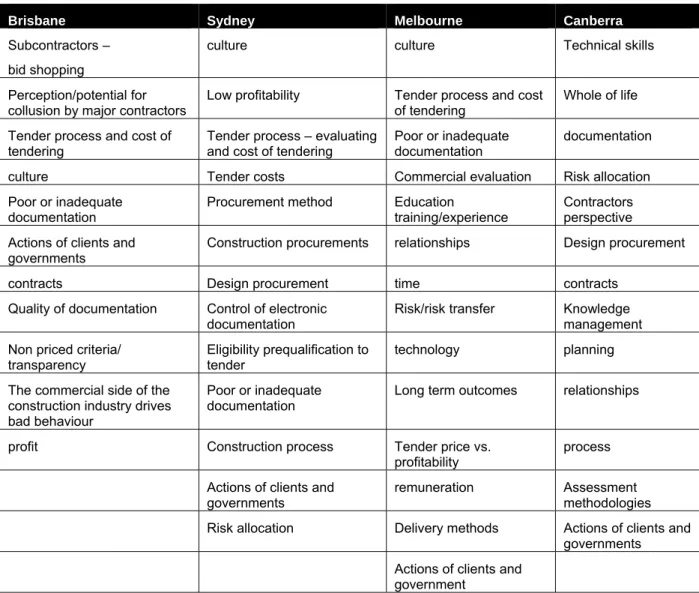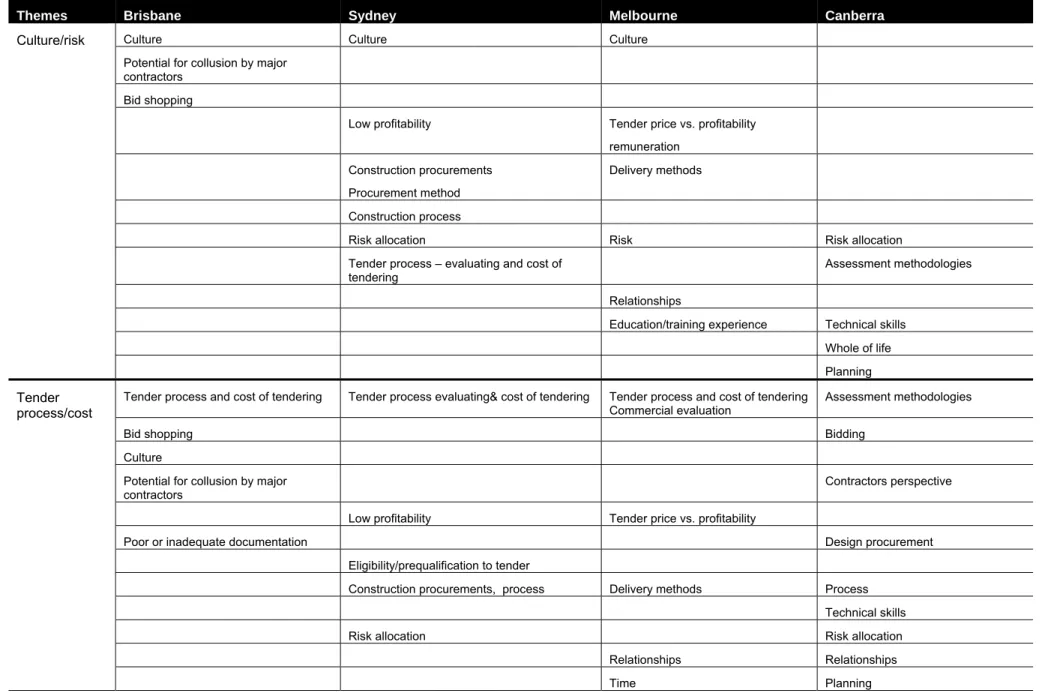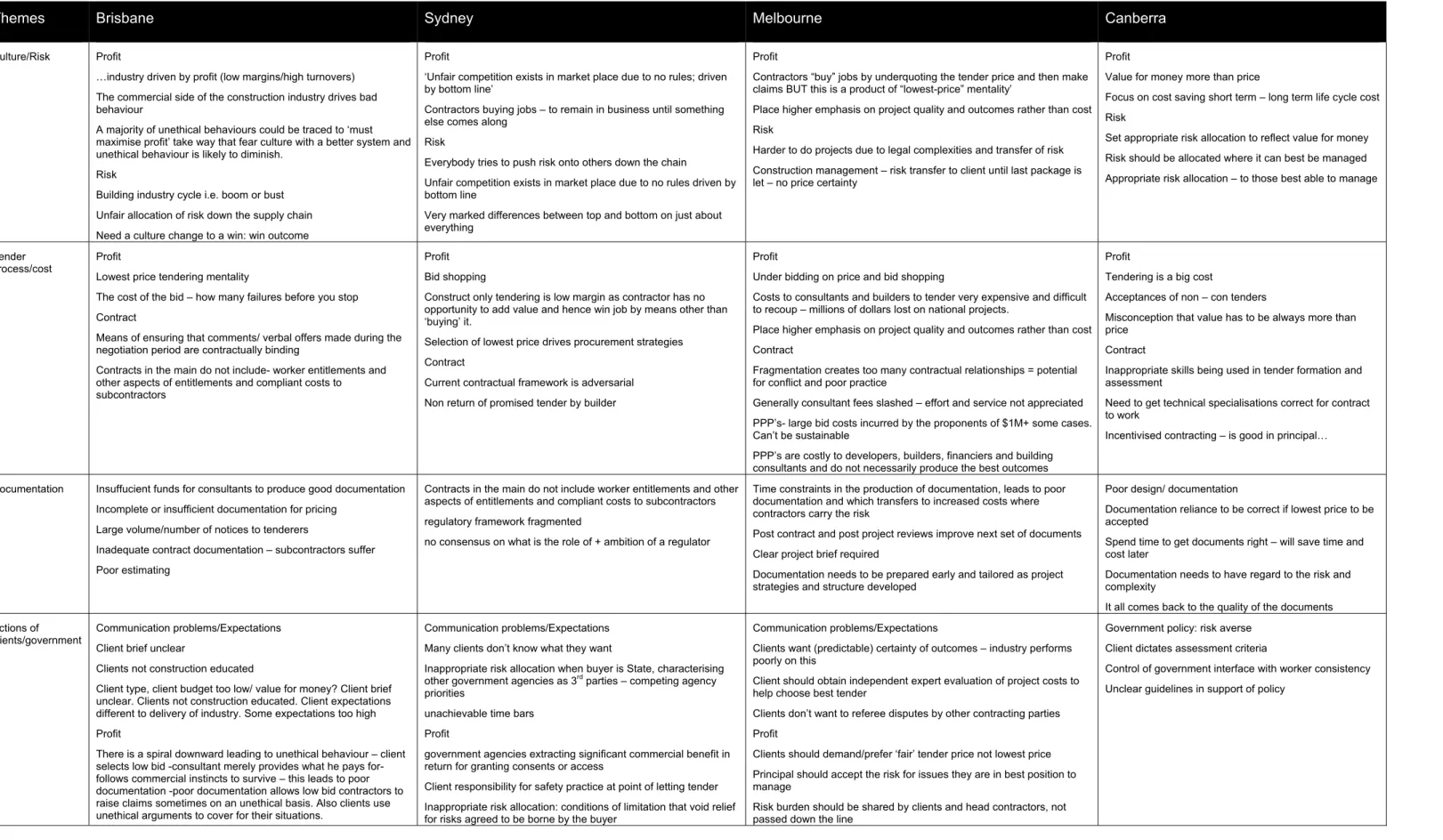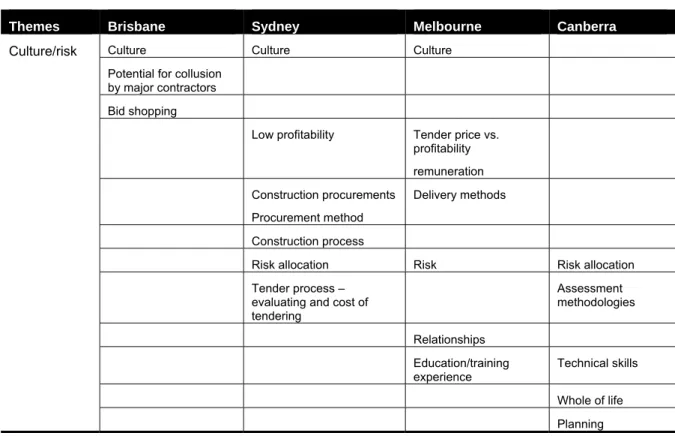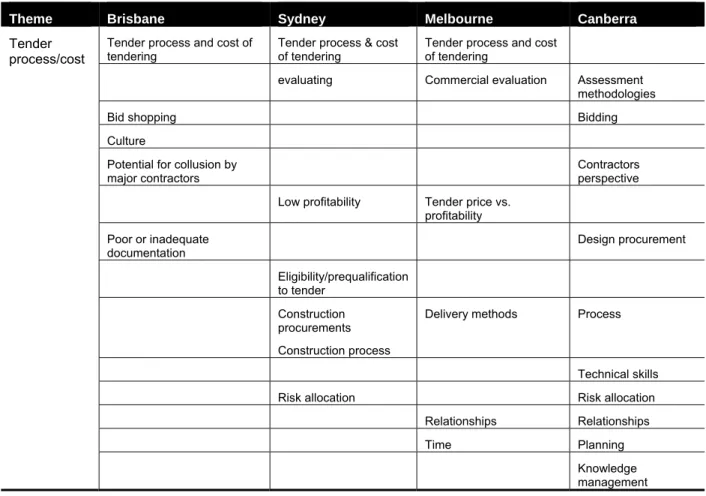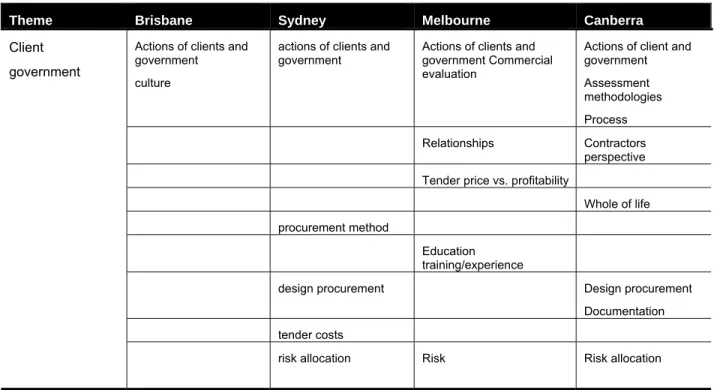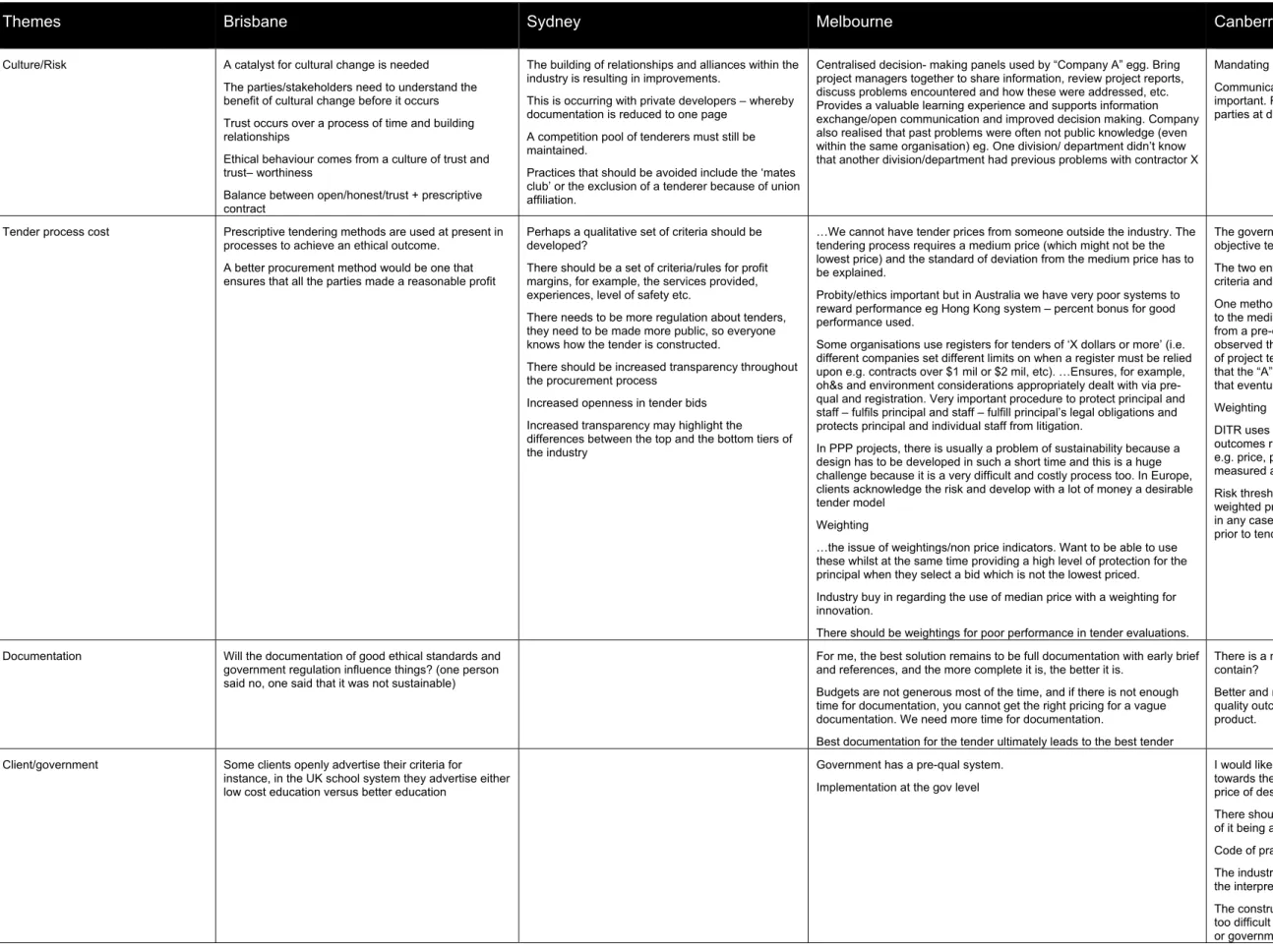Themes emerging from the workshops were then identified and discussed in light of the literature. Establishing ethical standards at the beginning of the procurement process provides an ethical platform for the project life cycle and. It is therefore important for industry members to identify for themselves what the ethical issues are in the Australian construction industry; including customers.
Comments from industry involved in the research workshops reveal concern about the unethical behavior evident within the industry. This study is limited by the size of the workshops and the number of participants. It is also limited due to the size of the workshops and the number of participants.
INTRODUCTION
LITERATURE REVIEW
Definition of Ethics
Ethics in Business
Ethics - theory and practice: normative vs. positive approaches
Codes of ethics and problems in practice
- Overview of Codes of practice
- Problems in practice
- Implementation
Conclusion
METHODOLOGY
Open Space technology
The moderator was chosen for her objective position and had no prior knowledge of the project to ensure that she would not 'lead' the discussion in any way. The only requirement of the 'open space' moderator is to ensure that at the end of the session the session leader brings to a central point a summary of the session's ideas. This certainly proved to be a limitation for the researchers when conducting their post data analysis.
Marked differences arose between the researchers' notes, and there were significant degrees of interpretation of the discussion that followed - it seems that there were differences in the understanding of the open space technology philosophy. This brings the discussion in this part of the report to the problem of data analysis. The post-analysis of the data also meant that the post-it notes from the butcher magazine had no context for us to locate the comments.
Thematic Analysis
RESULTS/DISCUSSION
Stage 1 Thematic Analysis
- Culture/risk
- The tender process
- Documentation
- Client/government
An example of the discrepancy between ethical theory and practice is Allen and Davis' (1993) study of business consultants in the US. In section 2.1 Definition of ethics, Figure 2.6 Box 2 Basic concerns of ethics, we were introduced to the concept of intention - the virtues and weaknesses of the motives that motivate them. Successful use of the Code requires knowledge of the Code and a willingness to follow the principles it espouses.
All comments from the participants and the solutions noted by the note-takers are included in the appendix. The descriptive table of comments shows some comments from the workshop participants. An integral part of the culture of the construction industry is managing risks.
The industry's high-risk culture can lead to unethical practices in the bidding process. This of course revisits the idea of intention that was raised in the definition section of the literature review.

Solutions documented by the note takers
- Culture/risk
- Tender process/cost –
- Documentation
- Client/government
CONCLUSION
It is also limited in that industry participants who attend such workshops may be predisposed to certain ethical behaviors, and there was no information about the participant's background. Despite providing a good basis for providing insight into the problems of improving ethical behavior across the industry; this special report, which focused only on workshop data analysis, should ultimately be viewed as a scoping study that will generate ideas for future investigations, development of other information for industry, or evaluations of existing programs and initiatives. If we think about the behavior of industry in relation to ethics, we could say that it is "organized" by policy, process and practice.
Code Mapping
Code Implementation Evaluation
Client Ethical Behaviour Study
Procurement Strategies
For the purposes of the research in our particular study, we are inclined to take a much broader view of the concept of 'professional ethics' and suggest that it is about the normative definition of professionalism in the construction industry. We define 'profession' to include all levels of the industry itself as well as the customer and government. Although some studies (Skitmore, 2003 and Ho et al, 2001) mention the role of the client in relation to the ethical decision-making process, there have been no studies that specifically look at the role of clients, including the role of the public client in relation to unethical. practice in the construction industry.
All jurisdictions in Australia – with the exception of the Australian Capital Territory, which has adopted a national code of practice – have their own codes of practice relating to the construction industry. Further support for the need to focus on implementation in relation to corporate codes of ethics is found in a case study of the construction industry in Hong Kong by Ho et al (2004). Although this lesson clearly influenced the development and implementation of the safety code, it did not extend to the code of ethics.
Greater openness in tenders. Greater transparency can highlight the differences between the top and bottom layers of the industry. Greater transparency can reveal the differences between the top and bottom tiers of the sector (Sydney). It is important to note that there may be disagreements regarding the effectiveness of the current material used in the industry.
Although profitability is low; lack of transparency in the tender process and tender costs; and the poor quality of documentation were high on the list of concerns. The main concerns related to the culture of the sector, especially in relation to its impact on. Documentation must take risk and complexity into account. It all comes down to the quality of the documents. The budgets are usually not generous, and if there is not enough time for it.
An appropriate percentage of the project budget should be devoted to the design phase of the Code of Practice. Increased transparency can highlight the differences between the upper and lower levels of the industry. There should be research on the basics of the procurement process, not its documentation.
Alternative Tendering Criteria & Process Demonstration Project
Tender Documentation Principles
Business Relationships
Due to a lack of research into ethics in the construction industry, the focus of the literature was broadened to look at ethics in business more broadly. While professional ethics are necessary to guide ethical behavior in business, the ethical behavior of the industry is still dependent on the personal ethics of employees. However, there is the customer who does not work regularly and therefore does not know much about the impact their purchasing strategy can have on the industry.
If this is the case, it is not the codes themselves that are important, but how the management of the company reacts to ethical decisions as a whole. The codes are only one method of the way in which various industry associations and government agencies can be used to strengthen the ethical business culture of all the participants in the industry. However, this practice is contrary to the literature, which suggests that codes of ethics by themselves are not effective in achieving an ethical culture, that it is the management of implementation at all levels in the construction supply chain that is critical. is.
One of the major flaws in the methodology is that it is merely a data collection technique and is largely silent on data analysis and therefore has inherent problems. All tables show that culture was a dominant theme of participants in all four cities. The level of documentation is generally considered to be a key component of the ability to develop these accurate offerings.
Part of this problem relates to the highly competitive culture within the industry, which creates a climate of secrecy; the lowest cost mentality and low profitability in the industry. Respondents were also critical of the way the government and bureaucratic organizations conducted business.
Apprentices and young graduates should be made aware of current industry practice Payment Process Security. Inadequate risk allocation – a change in legislation – should be a government risk where a government agency is the buyer. Improper Risk Allocation: Terms of restriction that invalidate relief for risks agreed to be borne by the buyer.
Risk burden should be shared by customers and main contractors, not transferred down the line. Spend more time on project brief development + save time and cost on project completion. Programs/tender must be realistic. Risk burden should be shared by customers and main contractors, not passed down the line. More difficult to do projects due to legal complexities and transfer of risk.
Lowest bidder means very little margin, so problems down the road Average tender prices – incentive to be creative and not low. PPP - risk matrix - the issue passes all the risk to the contractor. Risk should be allocated where it can be best managed. The tendering process requires an average price (which may not be the lowest price) and the standard of deviation from the average price must be explained.
The tendering process should be reviewed in educational institutions such as TAFE and universities. Focus should be on transparent and objective policies and procedures and substance rather than form – integrity auditor will not save an organization if their fairness plan and processes are weak. There should be a total separation from the design phase, instead of it being an element of the overall budget.
There should be a set of criteria/rules for profit margins, e.g. services provided, experience, level of safety etc. Practices to avoid include the 'mates club' or the exclusion of a tenderer due to his membership of a trade union. What is the catalyst for change. it will take a big advantage for change to happen).

